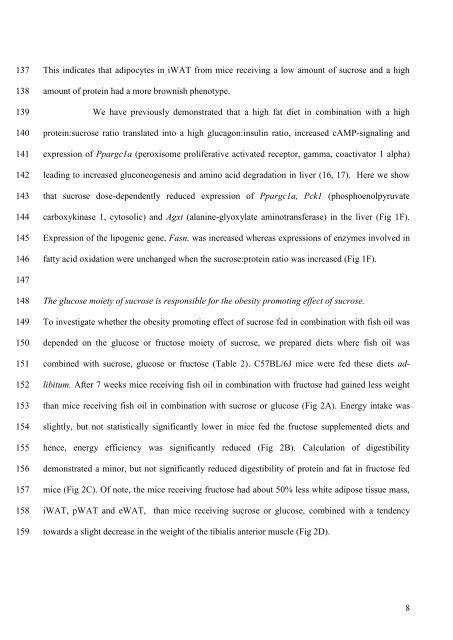The obesogenic effects of polyunsaturated fatty acids are dependent ...
The obesogenic effects of polyunsaturated fatty acids are dependent ...
The obesogenic effects of polyunsaturated fatty acids are dependent ...
Create successful ePaper yourself
Turn your PDF publications into a flip-book with our unique Google optimized e-Paper software.
137<br />
138<br />
139<br />
140<br />
141<br />
142<br />
143<br />
144<br />
145<br />
146<br />
This indicates that adipocytes in iWAT from mice receiving a low amount <strong>of</strong> sucrose and a high<br />
amount <strong>of</strong> protein had a more brownish phenotype.<br />
We have previously demonstrated that a high fat diet in combination with a high<br />
protein:sucrose ratio translated into a high glucagon:insulin ratio, increased cAMP-signaling and<br />
expression <strong>of</strong> Ppargc1a (peroxisome proliferative activated receptor, gamma, coactivator 1 alpha)<br />
leading to increased gluconeogenesis and amino acid degradation in liver (16, 17). Here we show<br />
that sucrose dose-<strong>dependent</strong>ly reduced expression <strong>of</strong> Ppargc1a, Pck1 (phosphoenolpyruvate<br />
carboxykinase 1, cytosolic) and Agxt (alanine-glyoxylate aminotransferase) in the liver (Fig 1F).<br />
Expression <strong>of</strong> the lipogenic gene, Fasn, was increased whereas expressions <strong>of</strong> enzymes involved in<br />
<strong>fatty</strong> acid oxidation were unchanged when the sucrose:protein ratio was increased (Fig 1F).<br />
147<br />
148<br />
149<br />
150<br />
151<br />
152<br />
153<br />
154<br />
155<br />
156<br />
157<br />
158<br />
159<br />
<strong>The</strong> glucose moiety <strong>of</strong> sucrose is responsible for the obesity promoting effect <strong>of</strong> sucrose.<br />
To investigate whether the obesity promoting effect <strong>of</strong> sucrose fed in combination with fish oil was<br />
depended on the glucose or fructose moiety <strong>of</strong> sucrose, we prep<strong>are</strong>d diets where fish oil was<br />
combined with sucrose, glucose or fructose (Table 2). C57BL/6J mice were fed these diets adlibitum.<br />
After 7 weeks mice receiving fish oil in combination with fructose had gained less weight<br />
than mice receiving fish oil in combination with sucrose or glucose (Fig 2A). Energy intake was<br />
slightly, but not statistically significantly lower in mice fed the fructose supplemented diets and<br />
hence, energy efficiency was significantly reduced (Fig 2B). Calculation <strong>of</strong> digestibility<br />
demonstrated a minor, but not significantly reduced digestibility <strong>of</strong> protein and fat in fructose fed<br />
mice (Fig 2C). Of note, the mice receiving fructose had about 50% less white adipose tissue mass,<br />
iWAT, pWAT and eWAT, than mice receiving sucrose or glucose, combined with a tendency<br />
towards a slight decrease in the weight <strong>of</strong> the tibialis anterior muscle (Fig 2D).<br />
8
















